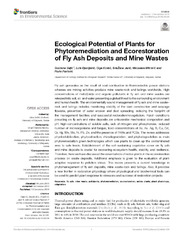Приказ основних података о документу
Ecological Potential of Plants for Phytoremediation and Ecorestoration of Fly Ash Deposits and Mine Wastes
| dc.creator | Gajić, Gordana | |
| dc.creator | Đurđević, Lola | |
| dc.creator | Kostić, Olga | |
| dc.creator | Jarić, Snežana | |
| dc.creator | Mitrović, Miroslava | |
| dc.creator | Pavlović, Pavle | |
| dc.date.accessioned | 2018-12-10T12:10:10Z | |
| dc.date.available | 2018-12-10T12:10:10Z | |
| dc.date.issued | 2018 | |
| dc.identifier.issn | 2296-665X | |
| dc.identifier.uri | https://www.frontiersin.org/article/10.3389/fenvs.2018.00124/full | |
| dc.identifier.uri | https://radar.ibiss.bg.ac.rs/handle/123456789/3196 | |
| dc.description.abstract | Fly ash generates as the result of coal combustion in thermoelectric power stations whereas ore mining activities produce mine waste-rock and tailings worldwide. High concentrations of metal(loid)s and organic pollutants in fly ash and mine wastes are released into soil, air and water presenting a global threat to the surrounding environment and human health. The environmentally sound management of fly ash and mine waste–rock and tailings includes monitoring stability of the dam construction and seepage flowrate, prevention of water erosion and dust spreading, reducing the footprint of the management facilities and successful restoration / revegetation. Harsh conditions prevailing on fly ash and mine deposits are unfavorable mechanical composition and pH, high concentrations of soluble salts, lack of nitrogen and phosphorous, reduced number of microorganisms and fungus, toxic concentrations of As, Au, Ag, B, Cu, Cd, Cr, Hg, Mn, Mo, Ni, Pb, Zn and the presence of PAHs and PCBs. The review addresses phystostabilization, phytoextraction, rhizodegradation and phytodegradation as main phytoremediation green technologies which use plants to clean up the contaminated area to safe levels. Establishment of the self–sustaining vegetative cover on fly ash and mine deposits is crucial for recovering ecosystem health, stability and resilience. Therefore, here we have discussed the essential role of native plants in the ecorestoration process on waste deposits. Additional emphasis is given to the evaluation of plant adaptive response to pollution stress. This review presents a current knowledge in phytomanagement of fly ash deposits, mine waste-rock and tailings. Also, it provides a new frontier in restoration physiology where physiological and biochemical tools can be used to predict plant response to stressors and success of restoration projects. | en |
| dc.relation | info:eu-repo/grantAgreement/MESTD/Basic Research (BR or ON)/173018/RS// | |
| dc.rights | openAccess | |
| dc.rights.uri | https://creativecommons.org/licenses/by/4.0/ | |
| dc.source | Frontiers in Environmental Science | |
| dc.subject | Ecorestoration | |
| dc.subject | Fly ash | |
| dc.subject | Mine waste | |
| dc.subject | Native plants | |
| dc.subject | Phytoremediation | |
| dc.subject | Adaptation | |
| dc.subject | Plant physiology | |
| dc.subject | Pollutants | |
| dc.title | Ecological Potential of Plants for Phytoremediation and Ecorestoration of Fly Ash Deposits and Mine Wastes | en |
| dc.type | article | en |
| dc.rights.license | BY | |
| dcterms.abstract | Гајић, Гордана; Ђурђевић, Лола; Павловић, Павле; Јарић, Снежана; Митровић, Мирослава; Костић, Олга; | |
| dc.rights.holder | © 2018 Gajić, Djurdjević, Kostić, Jarić, Mitrović and Pavlović. | |
| dc.citation.volume | 6 | |
| dc.identifier.doi | 10.3389/fenvs.2018.00124 | |
| dc.identifier.scopus | 2-s2.0-85056996684 | |
| dc.identifier.wos | 000452227800001 | |
| dc.citation.apa | Gajić, G., Djurdjević, L., Kostić, O., Jarić, S., Mitrović, M., & Pavlović, P. (2018). Ecological Potential of Plants for Phytoremediation and Ecorestoration of Fly Ash Deposits and Mine Wastes. Frontiers in Environmental Science, 6, 124. | |
| dc.citation.vancouver | Gajić G, Djurdjević L, Kostić O, Jarić S, Mitrović M, Pavlović P. Ecological Potential of Plants for Phytoremediation and Ecorestoration of Fly Ash Deposits and Mine Wastes. Front Environ Sci. 2018;6:124. | |
| dc.citation.spage | 124 | |
| dc.type.version | publishedVersion | en |
| dc.identifier.fulltext | https://radar.ibiss.bg.ac.rs//bitstream/id/4625/FrontEnvironSci_2018_6_124.pdf |

